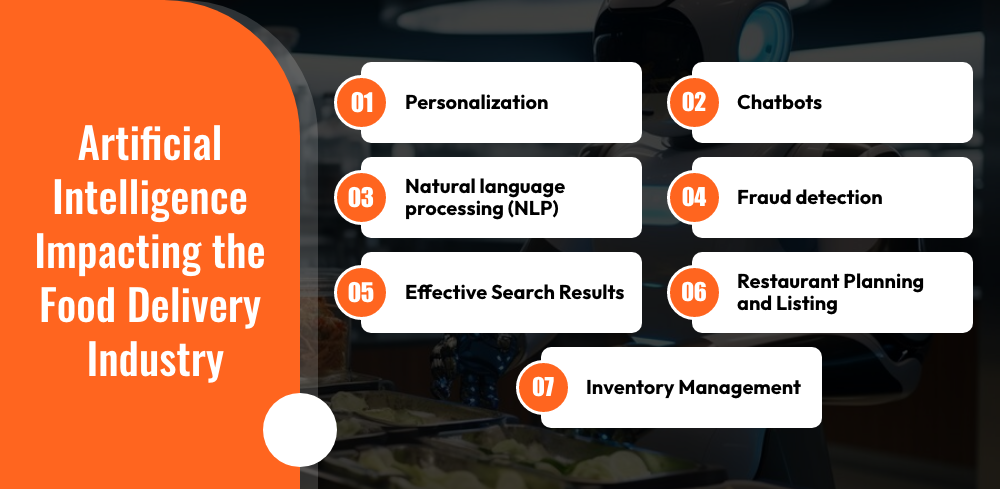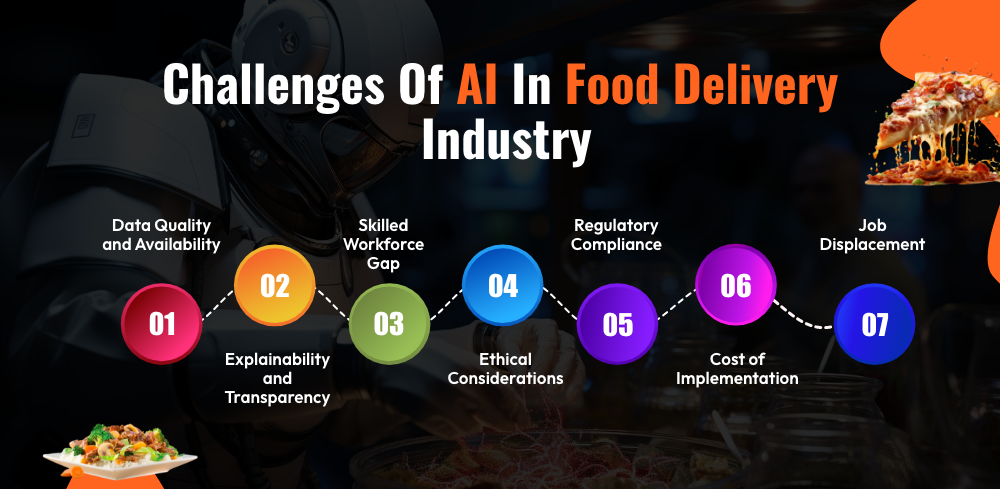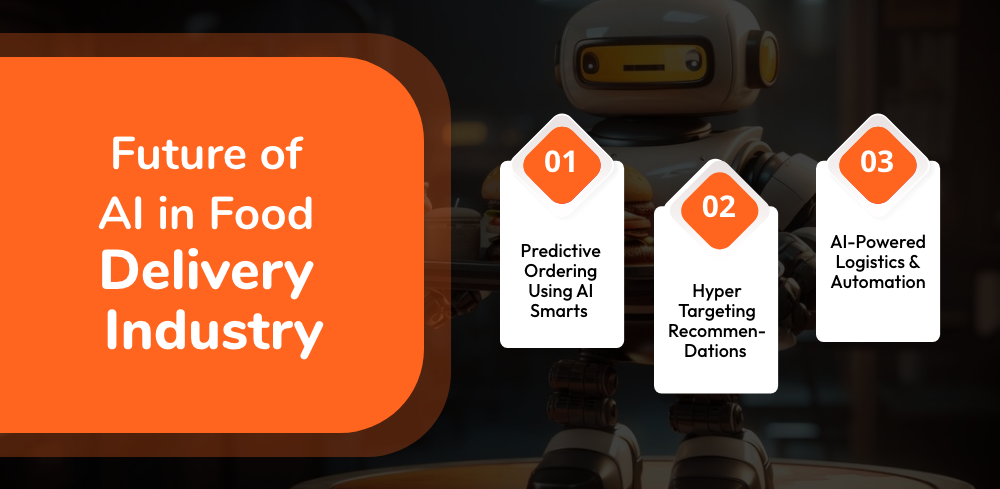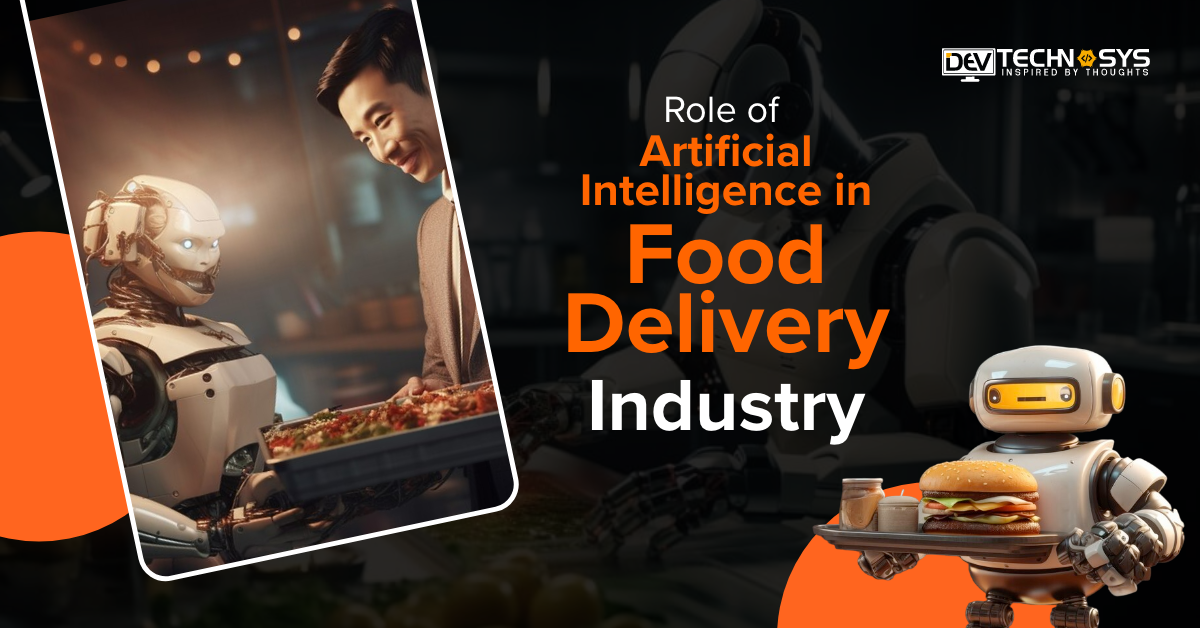Artificial Intelligence (AI) is at the heart of the food delivery industry’s development. In this blog, we’ll discuss the incredible ways AI is transforming the landscape of meal delivery apps.
AI is exploring every possible avenue, from personalization to efficiency to sustainability. However, it may be challenging to determine why food services or restaurants are looking for AI feature integration. Is it simply to keep up with trends, or can AI and machine learning define and play an important part in the future of the food sector?
The answer is simple, but before we get into the potential role of AI in food delivery industry, let’s take a step back and try to understand the background of the job.
The Food Delivery App: Facts and Figures
- The internet meal service industry is anticipated to generate $269.80 billion in revenue in 2023.
- By 2027, the market is estimated to be valued at $473.50 billion, with an annual sales growth rate of 15.10%.
- The restaurant service industry will earn 29% more money in 2024.
- By 2023, the food service market will be worth $182.90 billion.
- Regarding worldwide income, China is expected to generate $395 billion in sales by 2023.
- By 2023, the average customer in the food service business will spend $1,36,000.
- The food service industry will have approximately 189.40 million clients by 2027.
- By 2023, meal service users will account for 48% of the market.
How is Artificial Intelligence Impacting The Food Delivery Industry?
Artificial intelligence (AI) is transforming food delivery apps in new ways, making the customer experience smoother, more efficient, and even personalized. Here’s how AI affects meal delivery app development:

- Personalization
- Chatbots
- Natural language processing (NLP)
- Fraud detection
- Effective Search Results
- Restaurant Planning and Listing
- Inventory Management
1. Personalization
One of the true benefits of AI is its ability to develop food-serving apps. AI programs, created by Flutter app development company, can analyze previous orders, food preferences, and dietary restrictions to recommend the best meals and restaurants. This feature makes it simple for users to identify items that suit their nutritional requirements and preferences.
2. Chatbots
AI-powered chatbots are playing a significant role in restaurant ordering app development. Users can utilize chatbots to purchase orders, track deliveries, and contact customer care. The bot can also offer recommendations based on users’ previous orders, preferences, and nutritional requirements. Chatbots can manage many updates simultaneously, allowing food delivery apps to provide quick and effective customer support.
3. Natural language processing (NLP)
AI also enables computers to interpret human words, which is important in developing food-ordering apps. It can assist food delivery apps in handling user concerns and gathering vital data. For example, if a user types in “I want to order pizza,” the software can evaluate the search and recommend the best pizza businesses in the area. Similarly, if a user says, “I am allergic to nuts,” the app can propose non-nut-containing meals.
4. Fraud detection
Introducing AI into a food delivery app development company allows them to deal with scams in their apps. Food-detection algorithms can recognize patterns in user behavior to prevent scams such as false sales and stolen payment cards. They can also detect dodgy IP addresses using fingerprints. Fraud detection techniques can also assist food delivery apps avoid financial losses and keep track of their customers’ information. They can also improve prediction accuracy by identifying and deleting false orders.
5. Effective Search Results
Online food delivery applications search for cafes, restaurants, bars, and other establishments that receive a high volume of social media comments and ratings. Furthermore, AI recommends a nearby cafe or restaurant, ensuring that the user will most likely choose that location based on data from the current database. As a result, a meal delivery app development company or on-demand app developer uses AI to produce accurate search results.
6. Restaurant Planning and Listing
Since incorporating AI technologies into food service apps, businesses have been able to make quick decisions and plan ahead of time. Companies may now monitor genuine market trends and plan accordingly. It also assists meal delivery firms in selecting the most appropriate locations for their lists. When it comes to the food ordering and delivering app, these decisions are made using user data and AI software.
7. Inventory Management
Including AI in food service apps can save time and money by presenting potential outcomes. AI uses machine learning (ML) and facial recognition technology to assess whether food is out of date, out of supply, out of season, broken, or spoiled. It informs people about the staff changes, allowing them to cope with problems and act fast.
AI For Restaurants Use Case Example
Imagine how we could benefit from integrating AI in food delivery industry. Let’s say this program offers its consumers two very particular main features: group ordering, bill splitting, and the chance to donate money to charity foundations. Simply put, this software program was created to help customers place large meal orders for parties. To that end, this app targets businesses and business owners, allowing them to place daily orders for their staff and deliver them directly to the office.
At the same time, it can be utilized by regular users who have no affiliation with any possible companies with which this app has an agreement. Furthermore, every time a group purchases meals, a little charge is donated to organizations that specialize in combating food insecurity in local communities or worldwide.
Challenges of AI in Food Delivery Industry
AI in food delivery industry is transforming the food business, but it isn’t all plain sailing. Here are seven critical obstacles that must be overcome to ensure AI’s full potential on our plates:

- Data Quality and Availability
- Explainability and Transparency
- Skilled Workforce Gap
- Ethical Considerations
- Regulatory Compliance
- Cost of Implementation
- Job Displacement
1. Data Quality and Availability
AI thrives on high-quality, large datasets. Data collecting in the food business can be inefficient. Diverse farms, weather variations, and perishable products must be more consistent in statistics. Furthermore, some corporations may refuse to divulge proprietary recipes or food production knowledge.
2. Explainability and Transparency
AI-integrated food delivery apps can function like black boxes, producing outputs without disclosing the thinking behind them. This lack of transparency can have serious consequences for food safety. For example, if an AI system flags a batch of food as potentially contaminated, it is critical to understand why and take corrective action to maintain consumer trust.
3. Skilled Workforce Gap
To properly implement AI, a new type of worker is required: one who is knowledgeable about data science, AI, and food production. According to Android and iOS app development services providers, disparity between the current workforce and the necessary abilities for AI integration can be a significant barrier.
4. Ethical Considerations
Generative AI Food ordering software creates ethical considerations, specifically about bias. For example, if an AI personalized meal recommendations, may it encourage bad eating patterns among specific demographics? Furthermore, how can we ensure that AI does not worsen current disparities in the food system?
5. Regulatory Compliance
The ever-changing nature of AI makes it difficult to develop clear regulations. Food safety and consumer protection legislation must evolve to accommodate the potential threats posed by AI-driven procedures. Mobile app development services providers must ensure that the food delivery app comply with the regulation while maintaining safety standards.
6. Cost of Implementation
Building and deploying AI in food delivery app can be costly. Small and medium-sized food firms may struggle to invest in the required infrastructure and skills, thus growing the technical gap between major and small market participants.
7. Job Displacement
Automation by AI could result in job losses in certain sectors of the food business. According to the hybrid app development company, while AI may open up new opportunities, methods are required to support workers whose occupations are affected by technological progress.
What is the Future of AI in Food Delivery Industry?
Regarding the future of AI in food delivery industry, it has been predicted that the integration of AI with custom software development services will streamline operations. Additionally, it will also increase efficiency and enable better resource management. If you want to know more, just look at the following points:

- Predictive Ordering using AI Smarts:
- Hyper Targeting Recommendations:
- AI-Powered Logistics & Automation:
1. Predictive Ordering using AI Smarts:
AI-integrated food delivery app may pre-order your favorite lunch or recommend meals for upcoming events based on your preferences, weather patterns, and calendar events. Consider the app recommending a celebratory cake for your anniversary or preparing your favorite coffee for your weekly Monday morning order. This eliminates decision fatigue and provides a smooth dining experience.
2. Hyper Targeting Recommendations:
AI in artificial intelligence in food ordering apps will go beyond mere preferences. Consider the food delivery app development solutions that use your dietary restrictions, allergies, environmental concerns, and mood to provide the ideal meal. Your fitness tracker data may suggest a hearty soup on a cold day or a light salad. This level of customization will increase client pleasure and loyalty.
3. AI-Powered Logistics & Automation:
AI in food delivery industry will transform delivery. Autonomous vehicles, drones, and delivery robots will become commonplace. This might significantly cut travel congestion, pollution, and delivery delays, particularly in distant places. Consider drone deliveries for close eateries in minutes or self-driving cars that handle long-distance deliveries quickly. Further, integrating AI in app development for food ordering will enhance customer experience and efficiency.
Wrapping Up
Undoubtedly, AI in food delivery industry has changed how food business operates. Regardless of your future app ideas or additional features, such as machine learning in food delivery, you will undoubtedly need to discover and hire dedicated developers who can create the finest possible software product.
To make it even more effective and successful, we recommend that you seek for niche-experienced professionals who have already worked on similar projects (including white-label app development) in the sectors that you are interested in.
As a result, such hired app developers will be able to not only create a high-quality application but also advise you at every phase of the software development outsourced cycle, assist you in selecting the most appropriate tech stack, and, without a doubt, share knowledge with your in-house team, if any.
Frequently Asked Questions
1. What is the Automated Recommendations feature in Food Delivery Apps?
The Automated Recommendations feature in Food Delivery Apps is a technological solution that uses Artificial Intelligence (AI) to recommend food items or restaurants to users based on their tastes, order history, location, and other pertinent information.
2. How Does AI in Food Delivery Industry Benefit Restaurants and Food Providers?
AI in food delivery industry assists restaurants by offering food to potential clients based on their interests, which can result in more orders and money. It can also help eateries optimize their menu options.
3. How Much Does it Cost to Develop a Food Delivery App?
The cost to develop a mobile app varies greatly depending on aspects such as complexity, features, platform, and development location. A simple app might start at $8,000. However, more complicated applications with additional features can cost $25,000 or more, including design, development, testing, and regulatory compliance costs.
4. Can AI Assist with Regulatory Compliance in the Food Sector?
AI in food delivery industry has the potential to significantly improve food sector compliance. It can assess complex legislation, identify potential dangers, and automate label checks. This saves precious time for human experts to address complex regulatory concerns and assure food safety.






















